Ever wondered what makes a house truly stand out on the street? The secret often lies in its front elevation—the first impression that captures attention and sets the tone for the entire home. Front elevation designs are incredibly popular because they blend creativity with personality, transforming a simple façade into a striking visual statement.
From bold colors to architectural details, these elements not only boost curb appeal but also reflect your unique style and taste. In this article, you’ll discover a wealth of inspiring ideas and practical tips to elevate your home’s exterior.
Whether you prefer modern elegance or charming traditional touches, you’ll find diverse design concepts—from eye-catching paint choices and decorative stonework to innovative lighting and landscaping tricks—that can help you craft a captivating street appeal. Get ready to turn your house into an inviting, eye-catching masterpiece!
1. Incorporate Bold, Eye-Catching Exterior Paint Colors
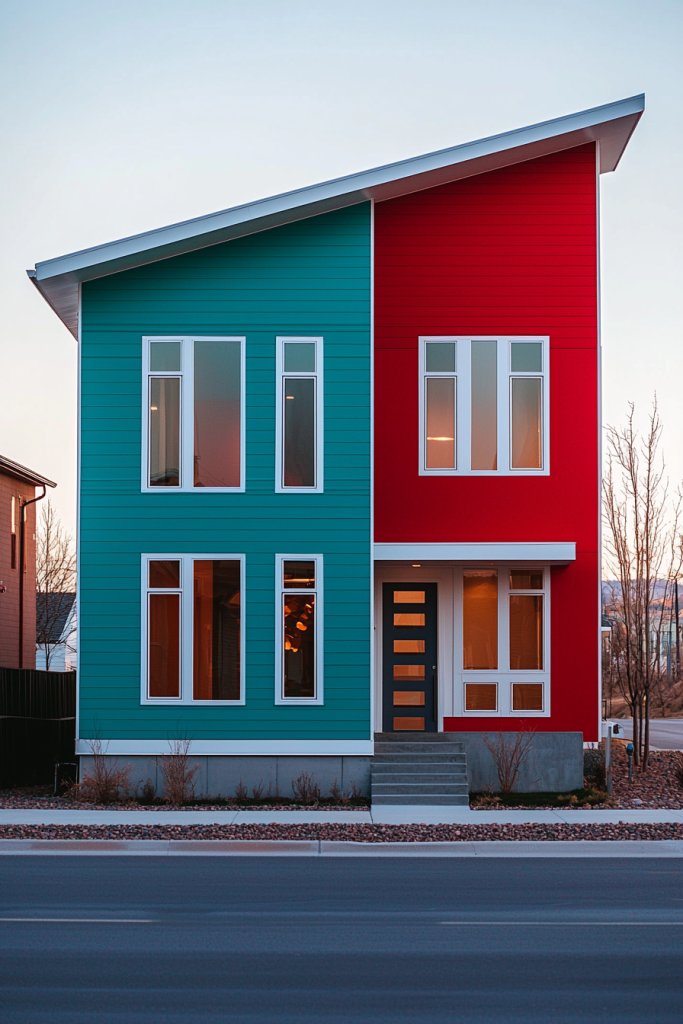
A vibrant, bold exterior paint color can instantly transform your home’s street appeal, making it stand out and leave a lasting impression. Choosing the right shade can reflect your personality and complement your surroundings, elevating your home’s overall aesthetic.
Imagine a striking navy blue façade accented with crisp white trim, or a warm terracotta hue that radiates warmth and charm. The paint’s texture appears smooth and matte, with sunlight casting gentle shadows that highlight architectural details.
The bold color creates a vivid contrast against lush greenery or neighboring homes, drawing eyes to your front elevation. This color choice energizes the entire street view, making your home both inviting and memorable.
To implement this idea, start by selecting a color palette that resonates with your personal style and the neighborhood vibe. Use high-quality exterior paint designed for durability and weather resistance—brands like Sherwin-Williams or Benjamin Moore offer excellent options.
Prepare your surface by cleaning and sanding it, then apply a primer if needed. For a more budget-friendly approach, consider using a semi-permanent paint chalk or peel-and-stick film for temporary bold accents, which can be updated seasonally or replaced easily.
2. Add Architectural Details with Decorative Masonry or Stonework
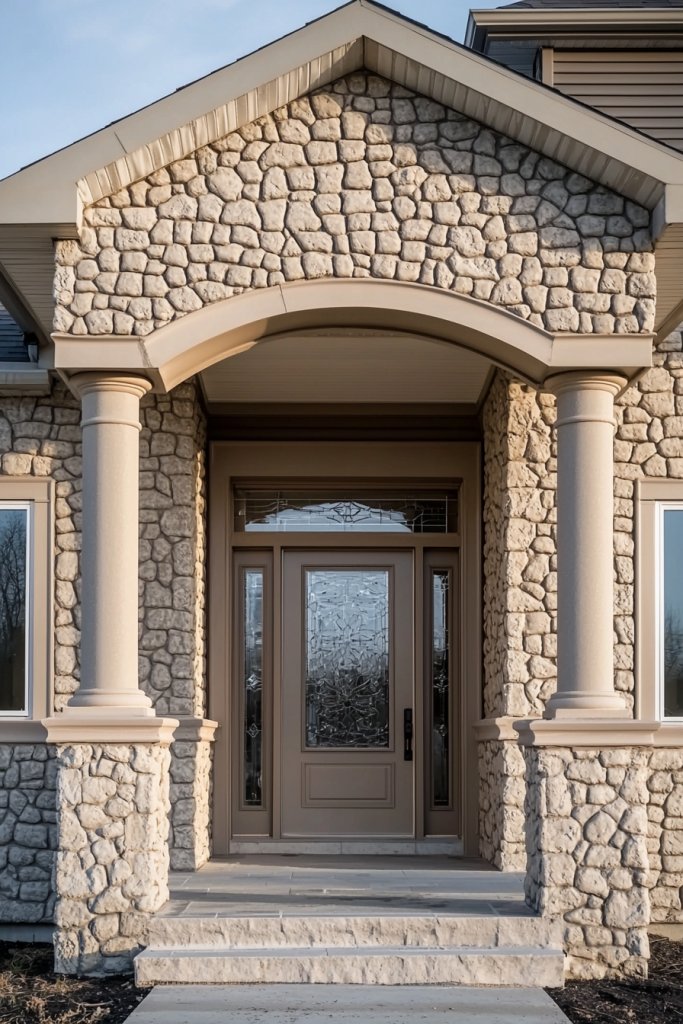
Decorative masonry or stonework adds texture and sophistication to your front elevation, creating visual depth and a sense of permanence. These details can highlight entryways, columns, or façade sections, giving your home a timeless or contemporary appeal depending on the materials and design.
Visualize a façade with a section of natural limestone or textured brick arranged in a herringbone pattern, complemented by smooth stucco walls. The roughness of the stone contrasts beautifully with sleek metal fixtures and crisp window trims, creating a tactile experience.
The subtle scent of mortar and stone adds to the sensory richness, while the varied textures play with light and shadow throughout the day. This layered approach enhances curb appeal by introducing natural elements that feel both luxurious and welcoming.
To achieve this look, begin by choosing quality masonry materials such as natural stone, cultured stone, or decorative brick. Consult with a mason or contractor to plan the placement—perhaps framing the entrance or creating a feature wall.
Simple stone veneer panels are a beginner-friendly alternative that can be installed with adhesive and minimal tools. Ensure proper sealing and maintenance to prevent weathering, especially in areas prone to moisture.
3. Install Stylish Front Door Designs with Unique Hardware
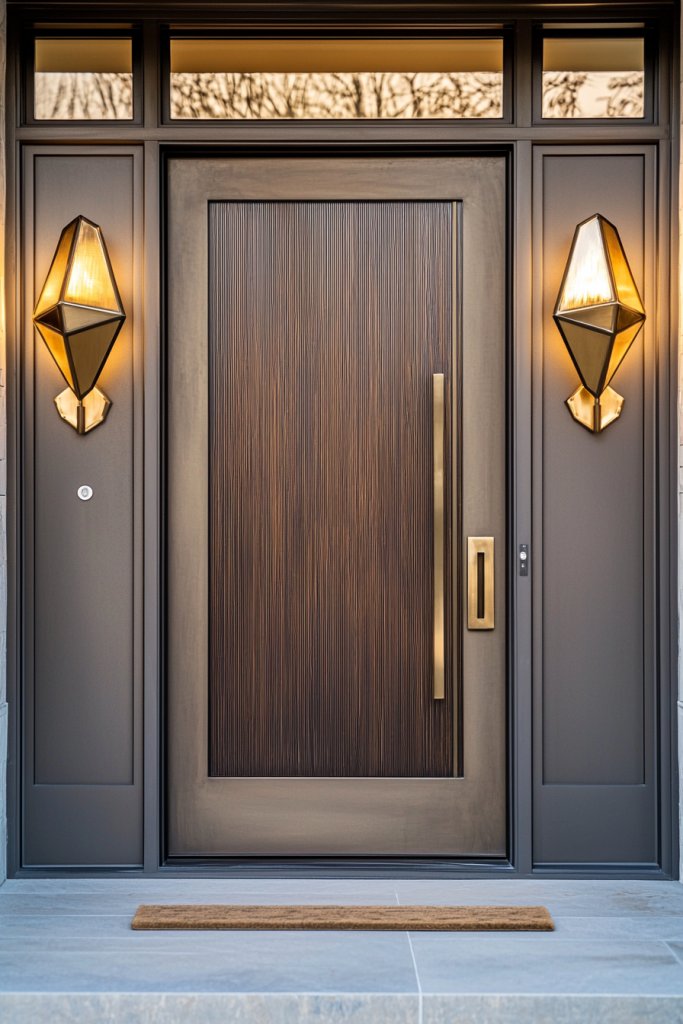
A striking front door is the centerpiece of your home’s exterior, setting the tone for the entire façade. Choosing a stylish door with distinctive hardware can elevate your street appeal and showcase your personal taste.
Picture a bold, arched wooden door painted in deep emerald green or classic black, featuring intricate carvings or panels. The hardware—such as vintage brass handles, ornate knockers, or modern matte black locks—adds a layer of personality and charm.
The door’s texture feels warm and inviting, inviting visitors to step inside. Complementing the door with a contrasting trim or decorative side panels brings balance and focus to the entrance, enhancing the overall aesthetic.
To bring this idea to life, start by selecting a high-quality door material like solid wood, fiberglass, or steel—each offers durability and style. Choose hardware that complements your home’s style: vintage brass for traditional homes, matte black for contemporary designs, or brushed nickel for a subtle touch.
For easy DIY installation, follow manufacturer instructions, ensuring proper alignment and sealing against weather. Adding a decorative kickplate or a seasonal wreath can further personalize your entryway.
4. Use Statement Lighting Fixtures to Highlight the Entrance
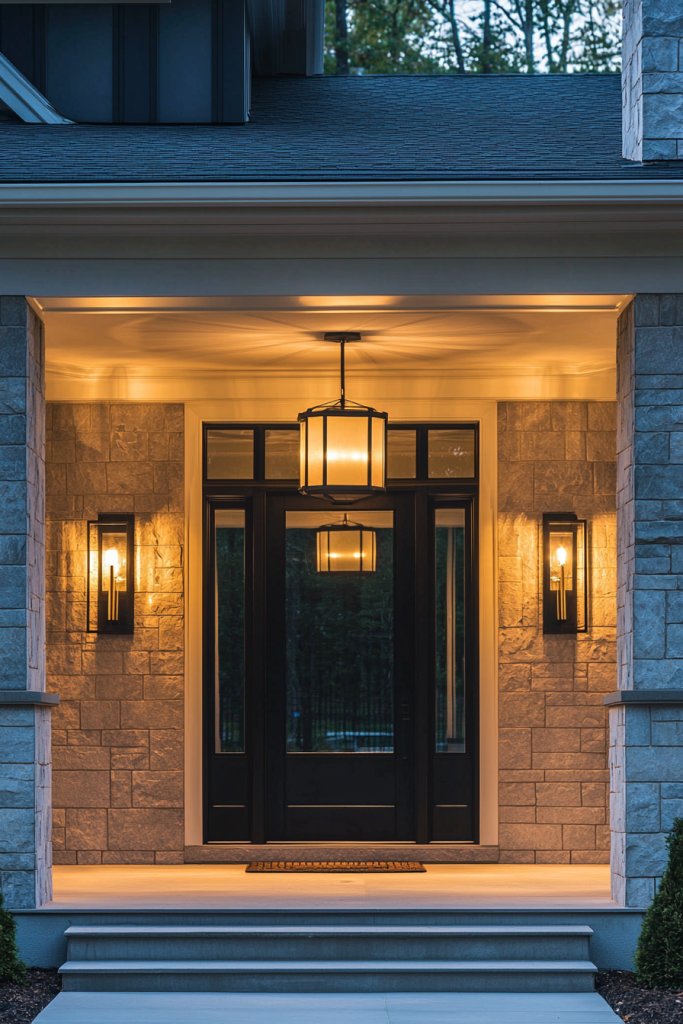
Statement lighting fixtures can dramatically enhance your front elevation by illuminating the entrance and creating visual interest after sunset. Proper lighting adds safety, warmth, and a welcoming ambiance that draws attention to your home’s façade.
Visualize a pair of vintage-inspired lanterns mounted on either side of the front door, casting a warm, golden glow over the pathway. Alternatively, modern sleek sconces with clean lines and dimmable LED bulbs can provide a minimalist yet impactful effect.
The light fixtures themselves become decorative elements, with finishes like matte black, antique brass, or brushed nickel adding texture and contrast. As the light plays over the textured wall surfaces and architectural details, it accentuates their shapes and creates a cozy, inviting atmosphere.
To implement this idea, select fixtures that match your home’s style—consider size, scale, and finish. Use weatherproof fixtures rated for outdoor use—brands like Kichler or Hinkley offer durable options.
Position the lights at eye level or slightly above, ensuring they evenly illuminate your entrance and walkway. Incorporate motion sensors or timers for convenience and energy efficiency. Installing the fixtures typically involves basic electrical work; if unsure, consult a licensed electrician to ensure safety and proper wiring.
5. Integrate Modern or Traditional Column Accents
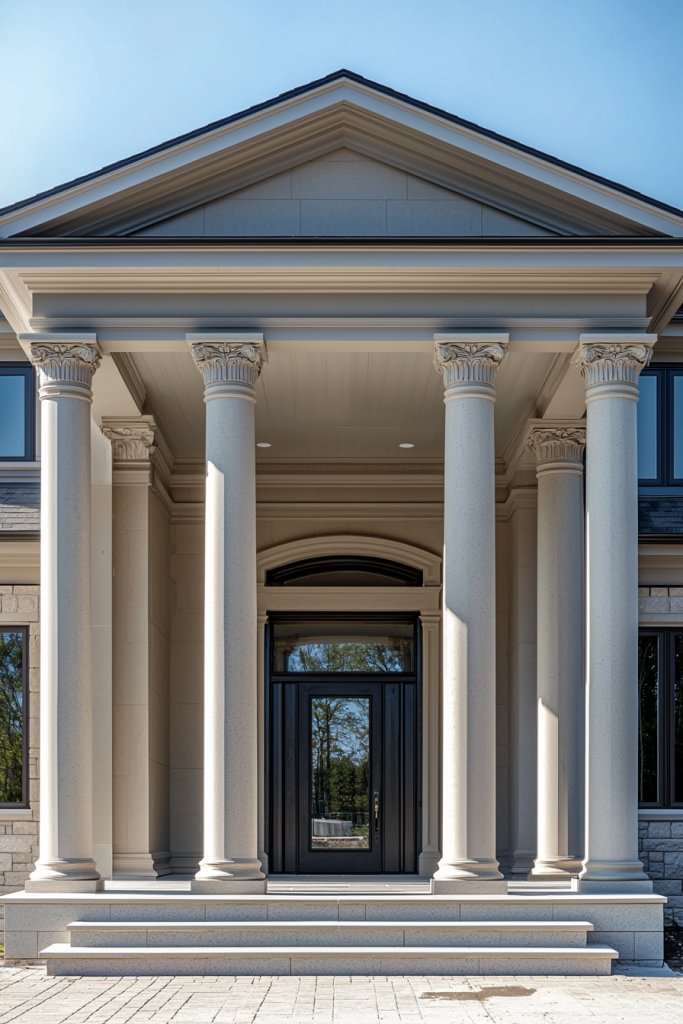
Columns add a classic or contemporary architectural element to your front elevation, framing the entrance or supporting a porch roof. Their presence enhances symmetry, grandeur, and structural interest, making your home appear more stately or inviting.
Imagine slender, fluted columns with ornate capitals supporting a small portico, painted in crisp white that contrasts with darker wall colors. Or, for a more modern look, sleek, square columns in concrete finish with minimalist lines.
The tactile surface of the columns and the shadows they cast contribute to a textured, layered façade. Whether traditional or modern, columns create a focal point at the entrance, guiding visitors naturally toward your front door while adding depth and height to the overall elevation.
To incorporate columns, start by determining their purpose—are they purely decorative or structural? For a traditional feel, opt for fiberglass, wood, or precast concrete columns with decorative capitals and bases. For a contemporary style, consider minimalist metal or smooth concrete columns.
Basic installation involves anchoring the columns securely to the foundation and attaching a supporting beam or roof. For DIY projects, prefabricated columns with mounting hardware simplify installation, while ensuring that they are proportionate to your home’s scale for a balanced look.
6. Design a Welcoming Front Porch with Comfortable Seating
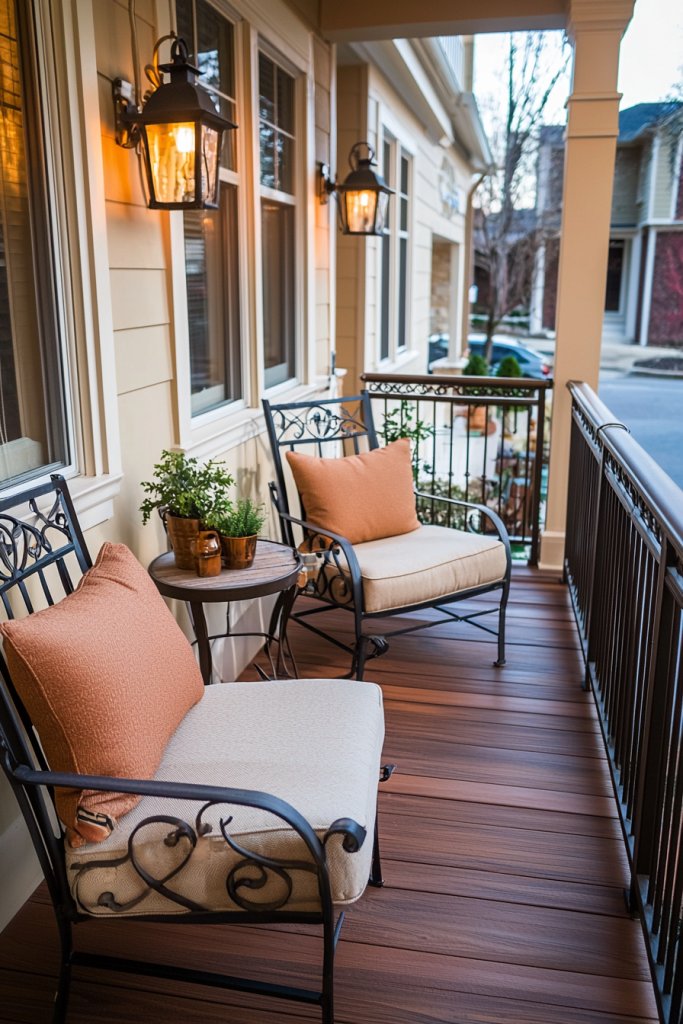
A well-designed front porch instantly elevates your home’s curb appeal and creates a warm, inviting atmosphere for visitors. It’s not just about aesthetics—it’s about crafting a space where people feel welcomed and relaxed before stepping inside.
Imagine a cozy porch painted in soft neutral tones, framed by a sturdy wooden or composite railing. A pair of plush, weather-resistant armchairs or a small loveseat with colorful, patterned cushions invites guests to sit and linger.
Add a rustic wooden coffee table topped with a vase of fresh seasonal flowers or a small lantern for ambient lighting. Incorporate textured textiles like a woven throw blanket or a chunky knit cushion to add warmth and tactile appeal.
The porch floor might feature decorative tiles or a welcoming doormat, while overhead, a stylish pendant or string lights cast a gentle glow in the evening. The overall scene feels inviting, with a blend of comfort and style that beckons visitors to pause and relax.
To create this welcoming space, start by choosing comfortable, durable seating—think weatherproof wicker chairs or composite wood benches—paired with colorful cushions made from fade-resistant fabric. Add a small side table or a coffee table made of reclaimed wood or metal for functionality.
Incorporate decorative elements like a woven throw blanket or textured pillows to boost comfort. For lighting, install string lights or a vintage-style lantern for soft illumination. Finish the look with a welcoming doormat and some seasonal decor, such as a wreath or potted plants, to personalize your porch and make it truly inviting.
7. Install Elegant Window Shutters for Visual Interest
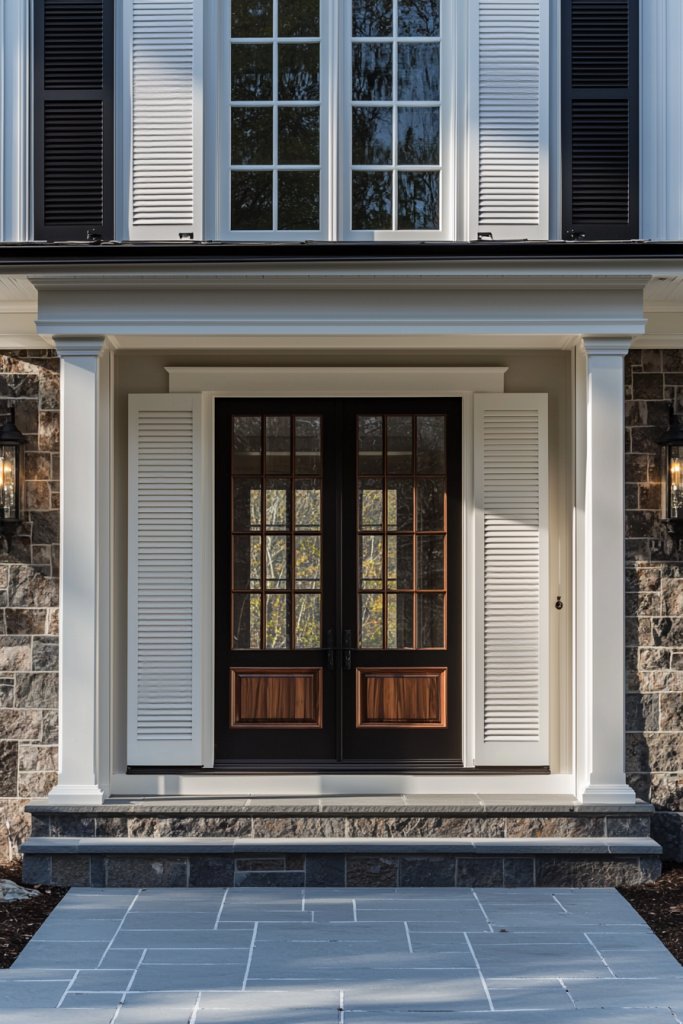
Adding window shutters is a classic way to enhance your home’s exterior charm while providing functional benefits like privacy and light control. They immediately add depth and architectural interest to your façade, making your home stand out in the neighborhood.
Visualize sleek, symmetrical shutters painted in contrasting colors—perhaps crisp white shutters against a deep navy or charcoal façade. The shutters are crafted from wood or composite, with decorative louvers or panels that align perfectly with the window frames.
They can be fully functional, opening to reveal the glass panes, or purely decorative, fixed in place for aesthetic appeal. When closed, they frame the windows beautifully, creating a charming, cottage-like vibe, especially when paired with traditional trim or molding.
The overall effect is a balanced, harmonious look that adds personality and sophistication to your front elevation. To install shutters, measure your windows accurately to ensure a perfect fit, then choose pre-made shutter kits or custom-make shutters from wood, vinyl, or composite materials.
For a simple DIY project, hinges, screws, and a drill are all you need to attach the shutters securely. Paint or stain the shutters in a color that complements your home’s palette—classic white, bold black, or a vibrant hue for a pop of color.
Mount the shutters with decorative hinges and ensure they open and close smoothly. Finish by adding hardware details like latch or strap accents for a charming, finished look.
8. Use Textured Cladding Materials for Depth and Contrast
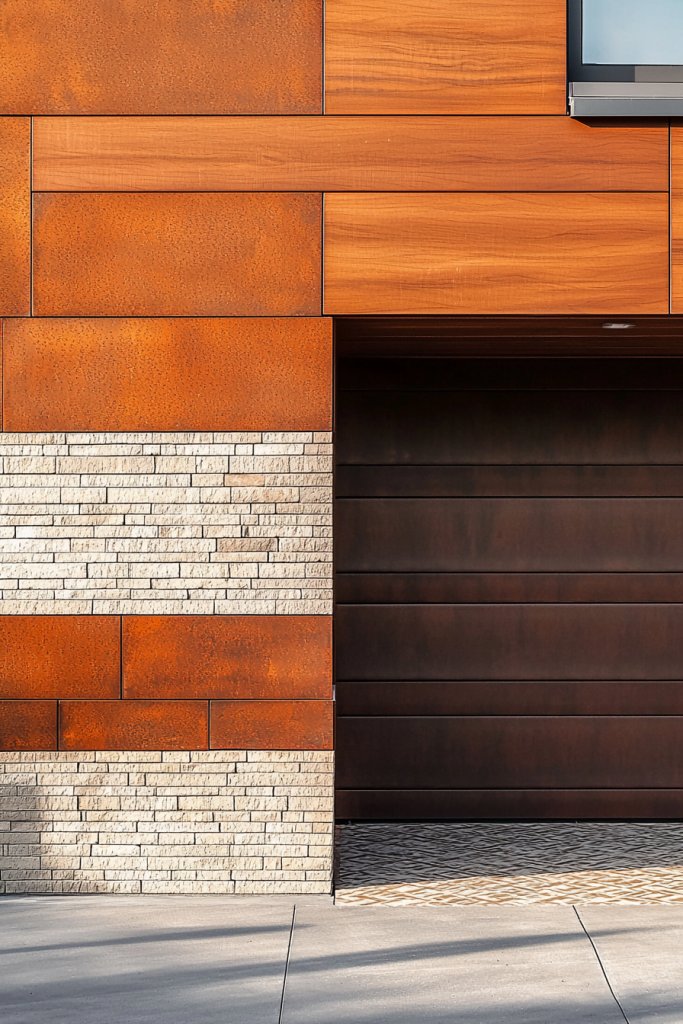
Applying textured cladding is an effective way to add visual depth and contrast to your home’s façade, making it more dynamic and captivating. It transforms a flat surface into a tactile and visually interesting feature that catches the eye.
Picture a façade where sections are clad in warm, rugged stone veneer, juxtaposed with smooth stucco or sleek siding. The stone provides a natural, earthy feel—rough, irregular surfaces in shades of beige, gray, or brown—while the smoother sections are painted in complementary tones, creating a layered, multi-dimensional effect.
Alternatively, you might use wood paneling with a textured grain or metal siding with raised patterns for an ultra-modern look. The interplay of different materials and textures creates a rich visual tapestry, enhancing the overall street appeal.
The textured surfaces also cast subtle shadows throughout the day, adding depth and intrigue. To incorporate textured cladding, start by selecting materials suited to your climate and budget—natural stone veneer, fiber cement panels, or decorative brick are popular choices.
Prepare the surface by ensuring it is clean and level before installation. Use appropriate adhesives or fasteners based on material type, and consider adding weatherproof sealant for durability.
For a DIY approach, opt for pre-finished panels or veneer sheets that are easier to handle. Pair textured cladding with smooth painted surfaces or trim to maximize contrast, and finish with accent lighting to highlight the textures at night, giving your home a striking, sophisticated curb presence.
9. Add a Pathway with Decorative Paving Patterns
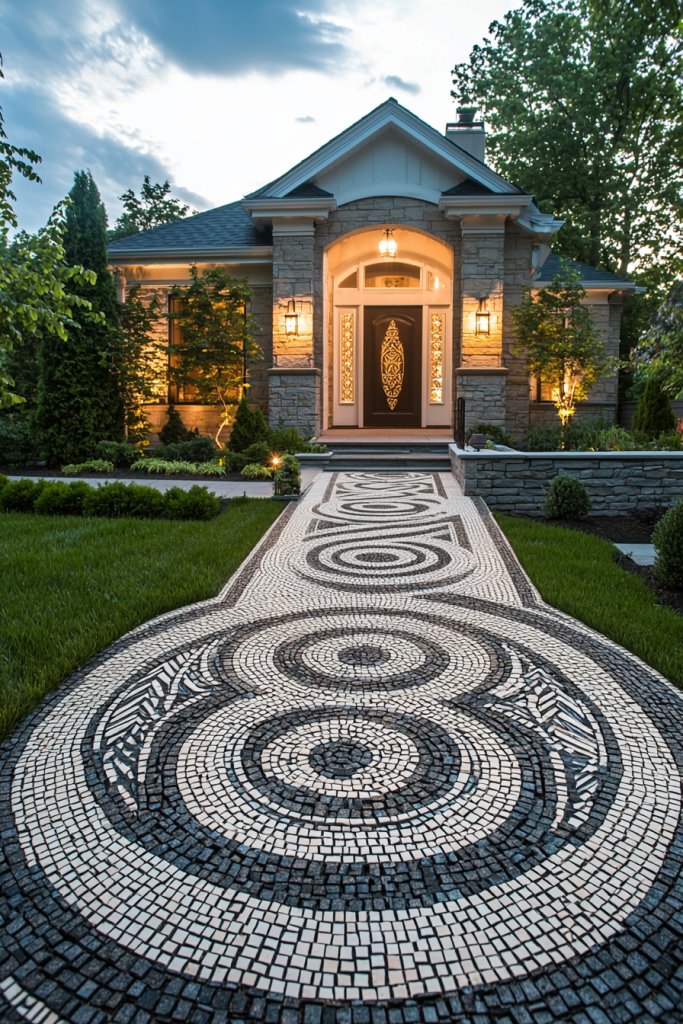
A beautifully designed pathway not only guides visitors to your front door but also acts as a central visual feature that elevates your home’s overall street appeal. Decorative paving patterns add character and charm, transforming a simple walkway into a statement piece.
Picture a winding pathway composed of brick pavers, decomposed granite, or concrete slabs arranged in intricate patterns like herringbone, circular, or basket weave. The colors can range from classic red or earth tones to sleek grays and whites, depending on your aesthetic.
The textured surface invites tactile exploration underfoot, while the pattern creates visual rhythm and movement. Bordering the pathway with low-growing shrubs, seasonal flowers, or solar pathway lights enhances the overall look and makes the entrance more inviting.
The pathway’s design seamlessly blends functionality with artistry, leading the eye naturally toward your front door. To create this feature, start by planning your layout and selecting materials that match your home’s style and your budget.
Measure the pathway length and width accurately, then choose pavers or stones that fit your pattern preference. Prepare the ground with a level foundation of gravel and sand, then lay your pavers carefully, ensuring tight joints.
Use edge restraints to keep the pattern intact. Finish with a compacted sand or fine gravel fill for stability, and add decorative elements like solar lights or border plants to complete the look. This DIY project can be as simple or elaborate as you wish, making your entrance both functional and artistically appealing.
10. Install a Decorative Gate or Fence to Frame the Entrance
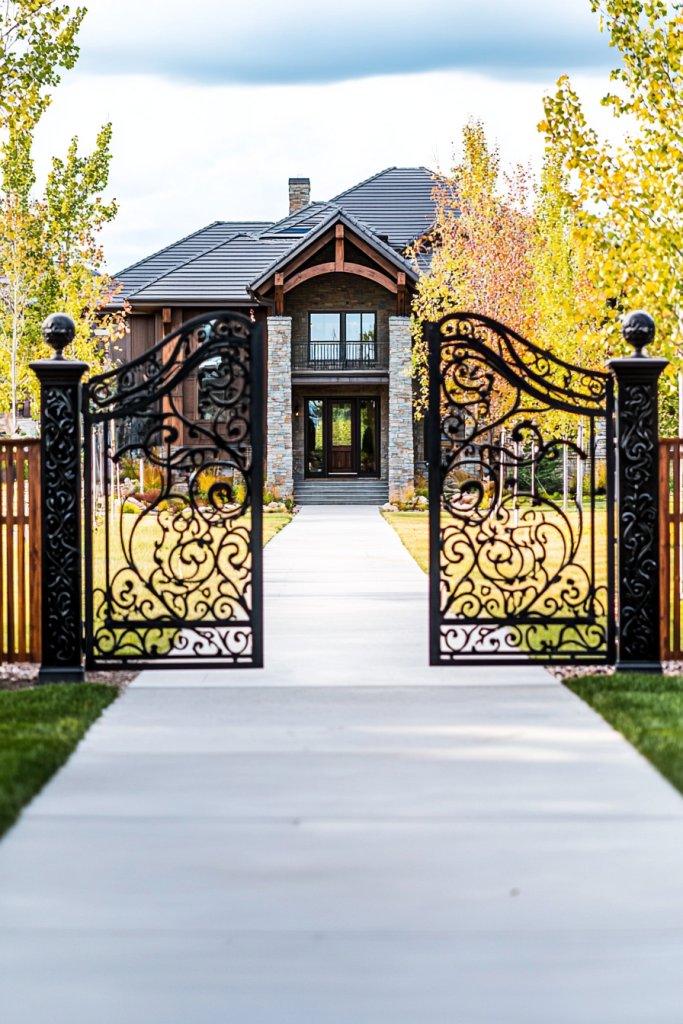
First impressions count, and a beautifully designed gate or fence can instantly elevate your home’s street appeal by framing the entrance with elegance and personality. A stylish gate acts as a welcoming handshake, setting the tone for your entire home’s facade.
Imagine a charming wrought iron gate with intricate scrollwork painted in matte black, paired with a matching fence that offers privacy without feeling closed off. Alternatively, a tall picket fence in crisp white or a sleek modern slat fence in natural wood tones can add charm or contemporary flair.
Adding decorative finials or custom house numbers on the gate creates a personalized touch, while the fence’s height and style can balance security with aesthetic appeal. Well-maintained, it can subtly guide visitors toward the entrance, making the transition from street to home seamless and inviting.
To implement this idea, start by choosing a style that complements your overall architecture—whether classic, modern, or rustic. For a DIY approach, you can purchase pre-made panels, then install them with durable posts secured into concrete foundations.
For a more intricate gate, consider consulting a metalworker for custom designs or purchasing ready-made decorative gates from home improvement stores. Use weather-resistant paint or protective coatings to ensure longevity, and add accessories like lanterns or decorative house numbers for extra visual interest. Regular maintenance, such as repainting or tightening fittings, will keep your fence or gate looking pristine year-round.
11. Use Vertical Garden Panels or Green Walls for a Fresh Look
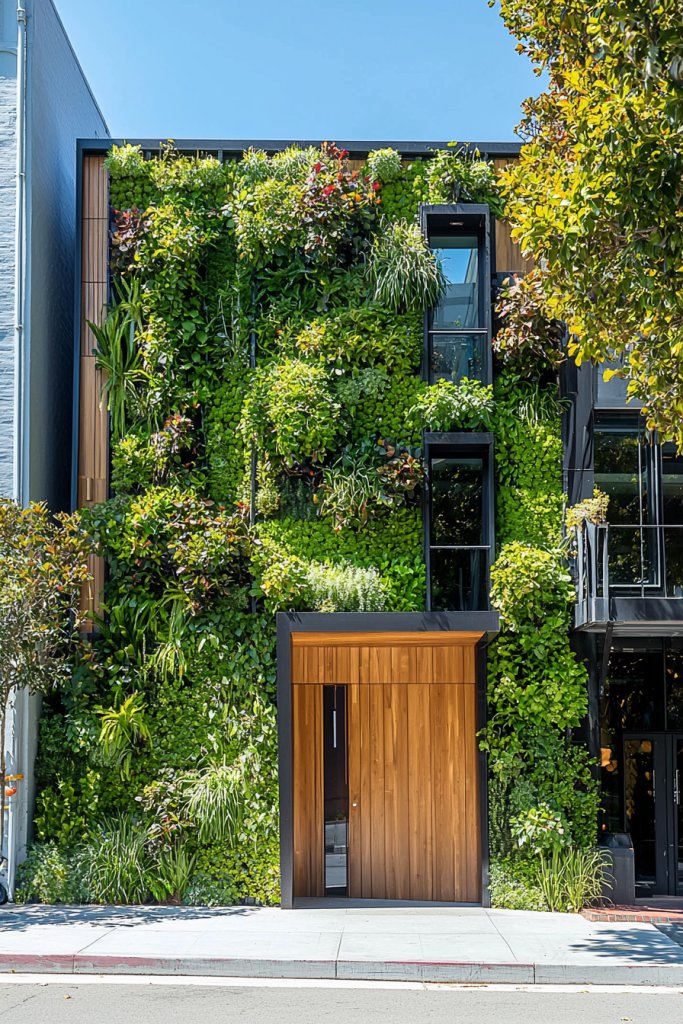
Transforming your front elevation with lush greenery not only adds visual interest but also creates a vibrant, refreshing atmosphere that instantly boosts curb appeal. Vertical garden panels or green walls serve as living artworks that bring nature directly to your home’s facade.
Picture a sleek, modular green wall made from panels filled with dense, thriving plants like succulents, ferns, or creeping vines. These panels can be mounted directly onto your exterior wall, offering a textured, layered appearance with shades of deep green, soft moss, or variegated leaves.
The tactile contrast between the lush foliage and surrounding materials like stone or wood creates a dynamic visual. During warm seasons, the greenery exudes a fresh, earthy scent, and the soft rustling of leaves adds a calming auditory element.
This living feature offers a modern, eco-friendly appeal that makes your home stand out. Getting started is straightforward: select a modular vertical garden system compatible with outdoor use—many are available at garden centers or online.
Choose plant varieties suited to your climate, considering light and water needs. Install the panels securely onto a sturdy wall or fence, ensuring proper drainage and watering access. Regular watering, pruning, and fertilizing will keep your green wall thriving, transforming your front yard into a lush, inviting oasis that changes with the seasons.
12. Incorporate Built-in Planters with Seasonal Flowers
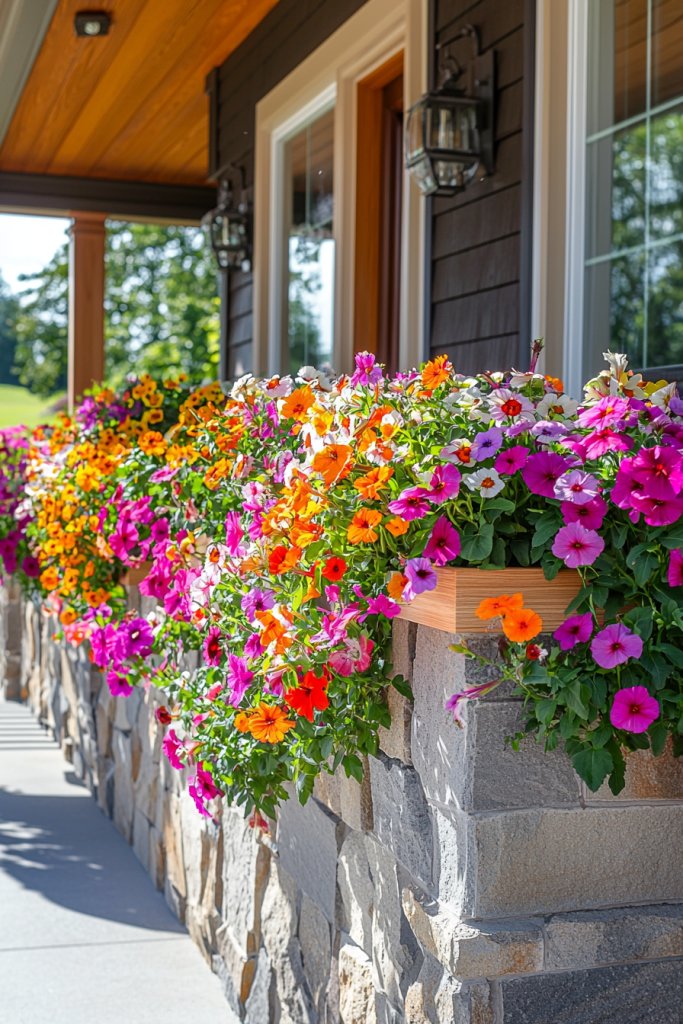
Adding built-in planters to your front elevation creates a charming, personalized touch that welcomes guests with bursts of color and fragrance. These planters blend seamlessly into your home’s architecture, offering a curated display of seasonal flowers that enhance the overall street appeal.
Visualize sturdy concrete or wood-lined planters integrated directly into the steps, porch edges, or window sills, filled with vibrant blooms like petunias, marigolds, or pansies. In autumn, switch to chrysanthemums and ornamental cabbages, while spring might feature tulips or daffodils.
The combination of textures—from the smooth planters to the delicate petals—creates a layered, inviting look. Fragrant flowers such as lavender or jasmine can add a sensory dimension, while the colorful display draws the eye from afar.
Well-maintained planters can make your home feel lively, welcoming, and thoughtfully designed. To implement, choose durable, weather-resistant materials like concrete, ceramic, or treated wood for your planters.
Position them at strategic points—near the entrance, along pathways, or beside windows—to maximize visual impact. Fill them with high-quality soil and select seasonal flowers suited to your climate and sunlight exposure.
Regular watering, deadheading, and fertilizing will keep your floral displays lush and attractive year-round. This simple addition transforms your front yard into a vibrant, ever-changing garden that warmly invites visitors and passersby alike.
13. Add Architectural Lighting to Highlight Facade Features

Lighting is a powerful tool to transform your home’s facade, highlighting its best features and creating a warm, inviting glow after sunset. Architectural lighting not only enhances curb appeal but also adds a layer of sophistication and safety to your front elevation.
Imagine installing sleek, energy-efficient LED floodlights that cast a gentle wash over textured stone walls, or subtle uplights that accentuate the elegant columns framing your entrance. You can also incorporate wall-mounted sconces with decorative metalwork, emitting soft, warm light that highlights intricate architectural details.
The play of light and shadow creates a dynamic, visually captivating facade, especially during twilight hours, giving your home an enchanting, almost cinematic presence. Choose warm white or amber tones to evoke coziness, while contrasting textures like smooth brick, rough stone, or smooth stucco come alive under the glow of well-placed fixtures.
Getting started is simpler than you might think. Select weatherproof LED spotlights or wall sconces that match your home’s style—think sleek modern designs or vintage-inspired fixtures—and position them strategically to highlight key features like entrance arches, textured walls, or decorative trim.
Use adjustable fixtures to direct light precisely where you want it, and consider solar-powered options for an eco-friendly approach. With a few basic tools, some outdoor-rated wiring, and thoughtful placement, you can easily create a stunning illuminated facade that transforms your home’s street appeal overnight.
14. Utilize Unique Roofing Materials or Styles for Visual Impact
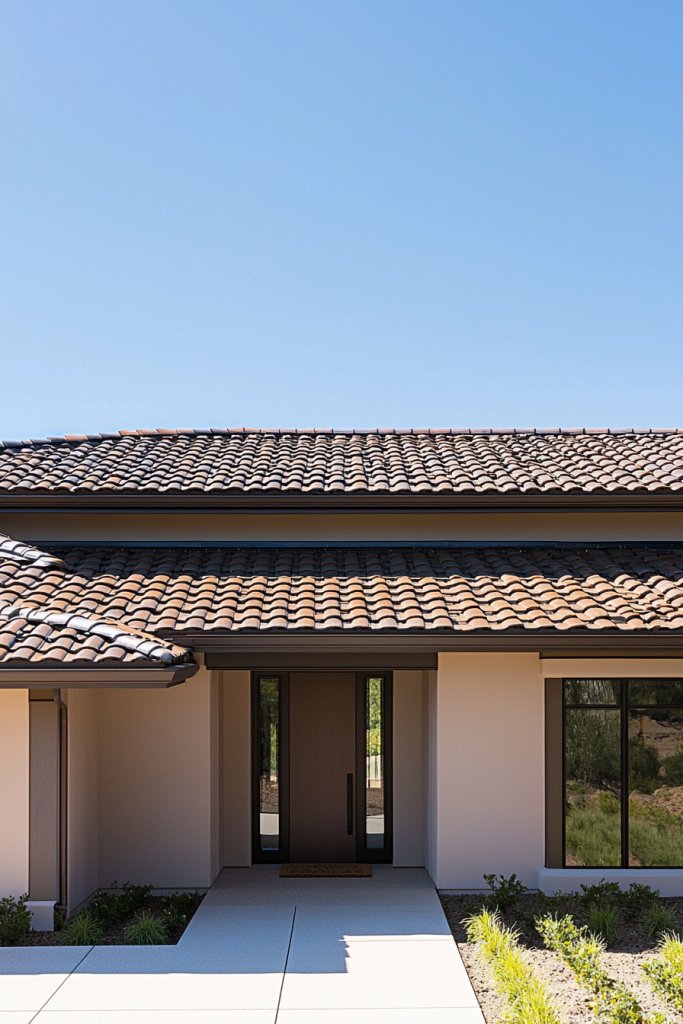
Transforming your home’s roof with unique materials or styles is a fantastic way to make a striking statement and elevate your front elevation’s overall appeal. Instead of sticking to traditional asphalt shingles, consider options like sleek metal roofing, vibrant clay tiles, or even eco-friendly green roofs that add texture and character to your home’s silhouette.
Imagine a roof covered in bold, terracotta-colored clay tiles with a slightly curved profile that catches the sunlight beautifully, or a modern flat metal roof in matte black that gives your house a contemporary edge. You could also opt for a layered look with different roofing materials, such as combining a wooden shake style with metal accents for visual interest.
The textures range from smooth and glossy to rough and rustic, creating a dynamic contrast against your facade, while the colors can vary from earthy browns and deep reds to metallic silvers and blacks. These distinctive roofing styles not only add visual depth but also evoke sensory feelings of warmth, strength, or sleek modernity.
To bring this idea to life, start by researching different roofing materials and styles that suit your home’s architecture and your local climate. You’ll need basic supplies like roofing panels, tiles, or shakes, along with underlayment and proper fastening tools.
For a DIY approach, many suppliers offer pre-cut or easy-to-install options, or you can hire a professional roofer for an expert finish. Alternatives like textured shingles or composite materials can also provide a similar visual impact without the complexity of traditional roofing installation. With some planning and creativity, your roof can become a stunning crown that dramatically enhances your home’s street appeal.
15. Incorporate Modern Art Sculptures or Decorative Elements near the Entrance
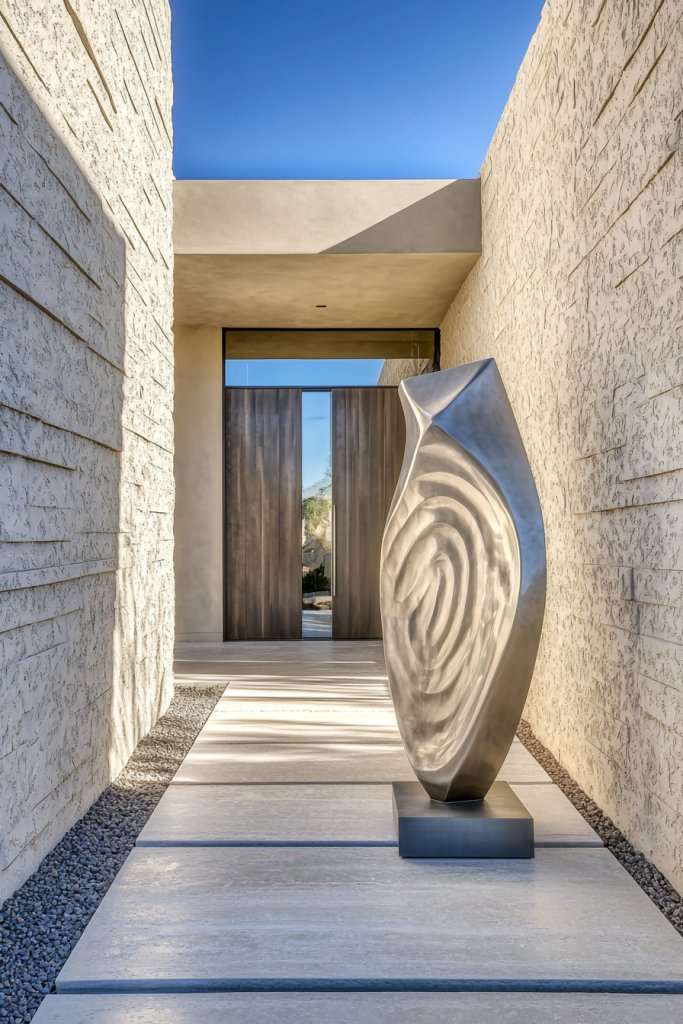
Adding modern art sculptures or decorative objects near your front entrance instantly elevates your home’s curb appeal, creating a striking focal point that captures visitors’ attention. This approach blends contemporary style with personal expression, making your home stand out in the neighborhood.
Imagine a sleek, abstract metal sculpture in a matte black finish standing confidently on a small paved platform beside your doorway, or a vibrant ceramic art piece with bold colors that contrast beautifully with your facade’s hues. The textures range from smooth, glossy surfaces to rough, organic finishes, adding tactile interest.
These elements can be minimalist geometric shapes or dynamic sculptures that seem to move with the wind, providing a sense of movement and vitality. The lighting around these pieces can be subtly highlighted with spotlights, emphasizing their forms at dusk and beyond.
To implement this idea, start by selecting sculptures or decorative objects that complement your overall home style—whether modern, eclectic, or artistic. For DIY-friendly options, consider purchasing ready-made pieces from local artisans or online stores like Etsy, or repurposing metal or concrete objects for a custom look.
Position your sculpture on a level, stable surface—such as a concrete slab or a decorative pedestal—and ensure it’s securely anchored. Finish with soft lighting to highlight the art after sunset, creating a warm, inviting glow that enhances your home’s street presence.
16. Use Textural Contrast with Mixed Materials (Wood, Metal, Stone)
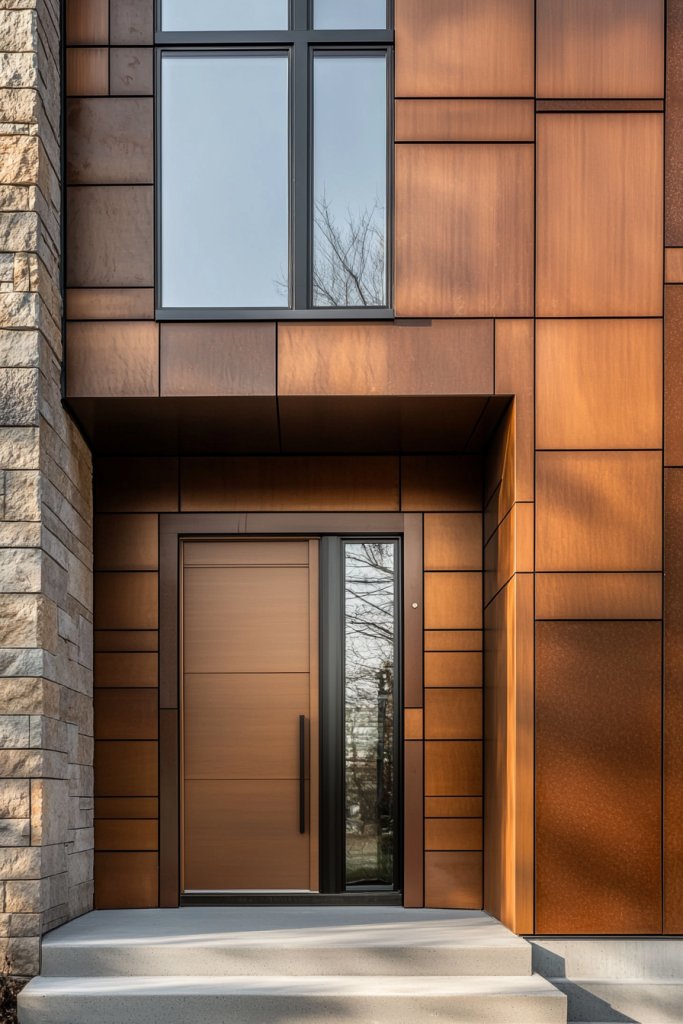
Creating visual interest through a mix of textures and materials on your front elevation breathes life into your home’s facade, making it more engaging and unique. Combining materials like wood, metal, and stone introduces depth and richness, elevating a simple exterior to a curated design statement.
Visualize a front wall with a stone veneer in warm earthy tones, paired with sleek, dark metal accents framing windows or doorways. A wooden porch with a natural, weathered finish adds warmth and softness, contrasting with the cool hardness of stone and the industrial feel of metal.
The textures invite tactile exploration—smooth glass, rough stone, grainy wood, and matte metal—creating a layered, multi-sensory experience. This combination results in an elegant, balanced facade that feels both modern and timeless, with varying shades that catch the light differently throughout the day.
To achieve this look, choose materials that suit your climate and budget. For example, cladding in textured stone or brick, weather-resistant wood like cedar or teak, and metal accents in powder-coated steel or aluminum work well together.
Start by planning a balanced layout—perhaps stone on the lower half, wood on the porch, and metal details around windows. Use adhesive, nails, or screws suitable for each material, and consider sealing or treating wood for longevity. The key is to keep the design cohesive by sticking to a harmonious color palette, ensuring a sophisticated, layered appearance that’s easy to maintain.
17. Install Large, Framed Windows with Decorative Trims
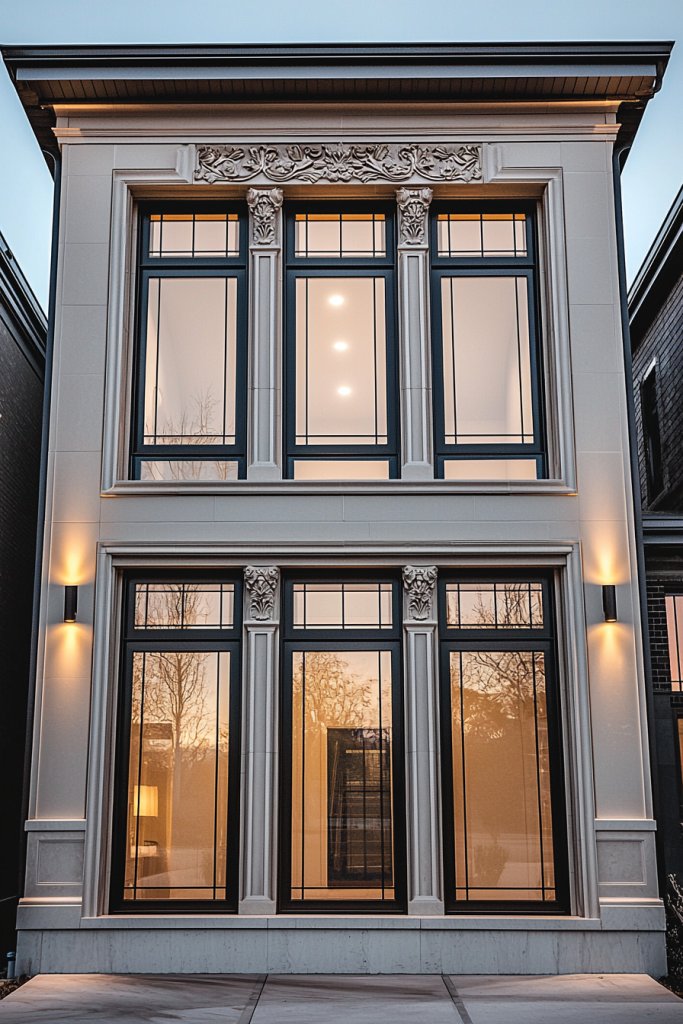
Large windows with decorative trims are a fantastic way to boost both the natural light and aesthetic appeal of your front elevation. They create a sense of openness and elegance, making your home appear more inviting and architecturally refined.
Picture expansive, floor-to-ceiling windows framed with intricate molding or decorative trims painted in a crisp white that contrasts beautifully against your facade’s color. These sizable panes allow abundant sunlight to flood the interior, creating bright, airy spaces inside.
The trims add character—think beveled edges, ornate cornices, or simple modern profiles—enhancing the architectural detail. When decorated with window boxes or shutters, these windows become focal points that draw the eye and add charm.
The overall effect is a sophisticated, balanced look that blends classic and contemporary styles. To implement, select windows that fit your home’s scale and style—consider options like aluminum or vinyl for durability and ease of installation.
Add decorative trims or mouldings using pre-made kits or custom woodwork, which can be painted or stained to match your aesthetic. Measure carefully to ensure proper fitting and alignment, and consider professional installation for larger units.
Finish with well-designed window hardware and, if desired, add window boxes with seasonal flowers for a touch of natural charm. This approach instantly modernizes your façade while maintaining timeless appeal.
18. Create a Symmetrical or Asymmetrical Façade for Visual Balance
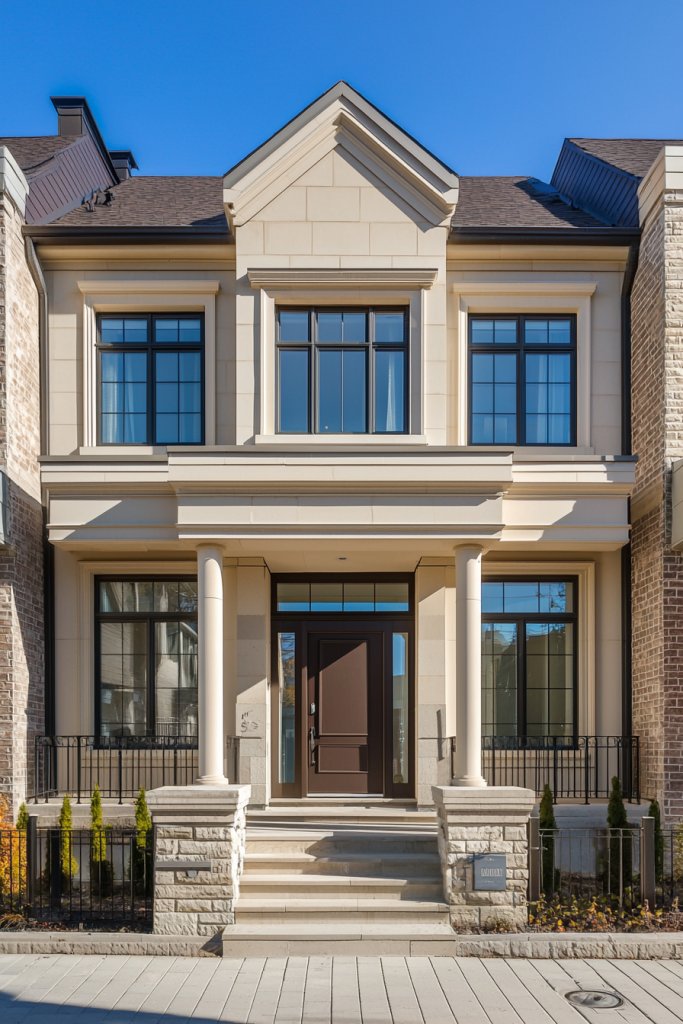
Designing your front elevation with either symmetry or asymmetry influences the visual impact and character of your home, helping it stand out while harmonizing with its surroundings. Symmetry offers a classic, orderly look, while asymmetry introduces modern flair and dynamic interest.
Imagine a symmetrical façade with evenly spaced windows and a centered front door, complemented by matching porch columns and balanced landscaping—creating a harmonious, formal appearance. Conversely, an asymmetrical design might feature a prominent, diagonally placed window on one side, a uniquely shaped porch, or varied-sized elements that give a sense of movement and contemporary style.
Both approaches can be enhanced with contrasting textures and colors—like a textured stone wall on one side and smooth stucco on the other—to emphasize the chosen balance or imbalance. Properly executed, both styles can greatly increase curb appeal by adding visual intrigue and personality.
To create this effect, first decide whether a balanced or bold, unbalanced look suits your personality and home style. For symmetry, replicate design elements on each side—matching windows, identical porch columns, and balanced landscaping.
For asymmetry, play with different window sizes, porch shapes, or decorative elements, ensuring they complement each other through color and material choices. Use tools like level and measuring tape to ensure precision. These subtle or striking decisions will make your front elevation memorable and uniquely yours, whether classic or modern.
19. Use Creative Landscaping Corners to Frame the Front Elevation
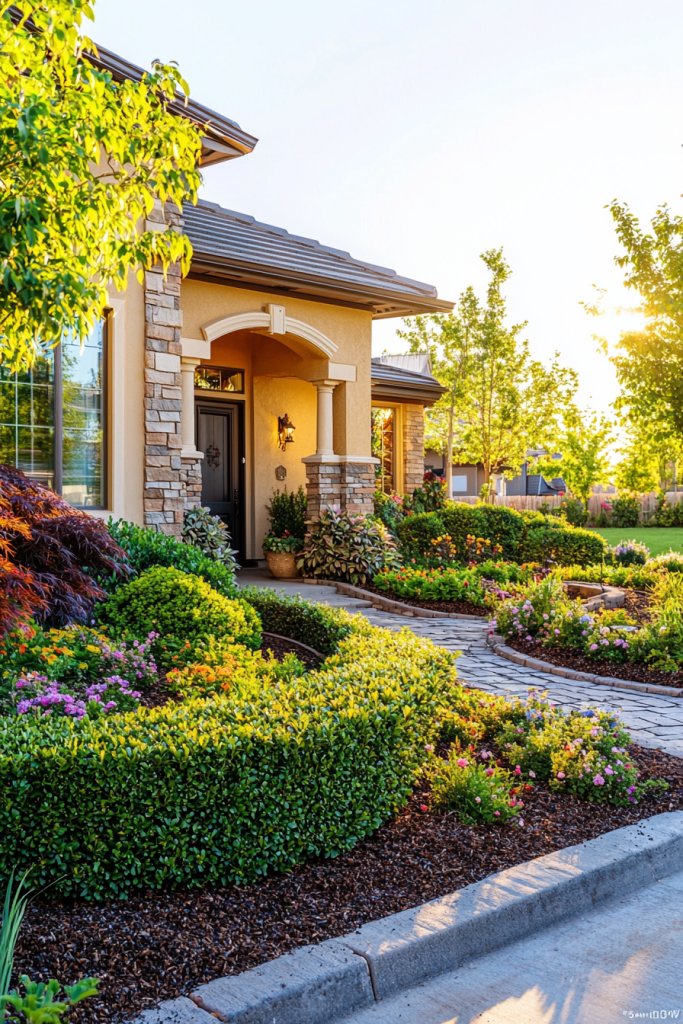
Strategically designing landscape corners around your front elevation adds depth, frames your home beautifully, and enhances street appeal with a lush, inviting atmosphere. Thoughtful landscaping directs focus toward your facade and creates a welcoming environment.
Visualize lush shrubbery, ornamental grasses, or flowering plants arranged in curved beds or geometric shapes at the corners of your yard. Incorporate elements like decorative stones, mulch, or small pathways to define these spaces.
Tall plants such as bamboo, ornamental grasses, or small trees like Japanese maples can create vertical accents, framing your entrance from different angles. Layering textures—smooth stones, soft greenery, and vibrant blooms—produces visual contrast that draws the eye inward toward your home.
Adding lighting along pathways or within plant beds further enhances the visual impact at night, creating a cozy, enchanting glow. Begin by assessing your space and choosing plants that suit your climate and maintenance preferences.
Use durable edging materials like metal or stone to contain beds and define space. Incorporate decorative elements—such as lanterns, sculptures, or small water features—to add personality.
Plant in clusters for a lush effect, and consider varying heights and colors for visual interest. Regular pruning and mulching keep your landscaping looking fresh and inviting, making your front yard a picturesque frame that complements and elevates your home’s overall street appeal.
20. Incorporate Artistic Metalwork or Decorative Grilles
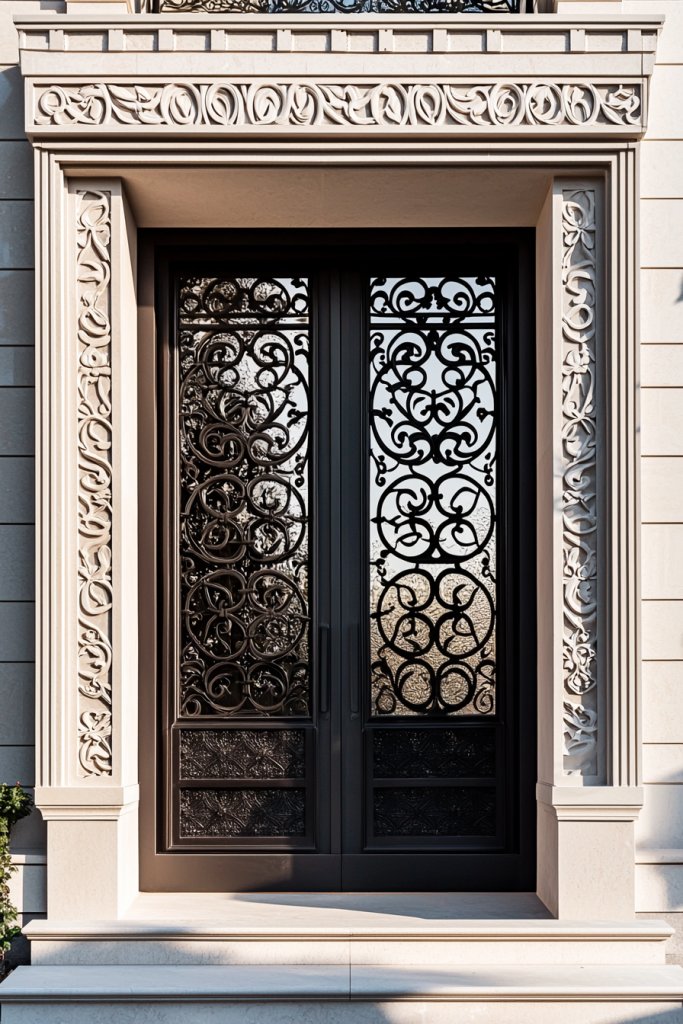
Adding artistic metalwork or decorative grilles to your front elevation can dramatically elevate its visual appeal, transforming a simple façade into a statement piece. These intricate metal accents serve as focal points that draw attention and add a layer of sophistication, blending craftsmanship with modern design trends.
Well-designed metalwork not only enhances aesthetic charm but also introduces texture and depth, making your home stand out on the street. Imagine a sleek, wrought iron grille with ornate floral patterns framing your front door, or a custom-designed metal screen with geometric cut-outs that cast mesmerizing shadows throughout the day.
These elements can be painted in bold black, brushed gold, or even vibrant colors to complement your overall color scheme. The contrast of shiny, matte, or textured finishes adds richness and tactile interest.
The design can be subtle, like delicate scrollwork, or bold, like abstract sculptures—either way, it creates a striking visual impact that complements other façade features such as lighting and landscaping. To implement this idea, start by selecting a design that resonates with your home’s style—whether classic, contemporary, or eclectic.
Source high-quality metal materials such as wrought iron, aluminum, or steel from local fabricators or online suppliers. For beginners, pre-made decorative grilles or panels are a practical choice, or consider working with a metal artist for custom pieces.
Attach the metalwork securely around your front door, windows, or as a standalone feature using appropriate fasteners and protective coatings to prevent rust. Finishing with a clear sealant will ensure longevity and sustained beauty.
21. Add a Canopy or Awning with Stylish Fabric or Metal Designs

A canopy or awning over your front entrance provides both functional protection from the elements and an opportunity to introduce stylish design elements. When chosen thoughtfully, it becomes a defining feature that frames your doorway and lends your home a polished, inviting look.
Whether made from fabric or metal, a well-designed canopy adds a layer of texture and visual interest that elevates your front elevation. Picture a sleek, curved metal canopy with a matte black finish that extends slightly beyond the doorway, creating a dramatic silhouette.
Alternatively, envision a vibrant canvas awning in a bold color or pattern—such as navy stripes or floral motifs—that offers a cheerful splash of personality. The materials can range from durable powder-coated steel or aluminum to weather-resistant canvas or acrylic fabrics.
For a cozy, vintage feel, consider a striped fabric with decorative fringe, while a minimalist approach might favor clean-lined metal with subtle detailing. The canopy not only enhances curb appeal but also provides shelter and comfort during rainy or sunny days.
Implementing this feature involves measuring your doorway and selecting a size that offers adequate coverage without overwhelming the façade. For metal canopies, professional fabrication and installation are recommended to ensure safety and stability, but DIY kits are available for smaller, simpler designs.
Fabric awnings can be installed using sturdy brackets and tension rods, with weatherproofing treatments for longevity. Choose colors and styles that harmonize with your home’s overall palette, and add decorative lighting underneath for a warm, welcoming glow at night.
22. Use Reflective Surfaces or Glass Elements to Modernize the Facade
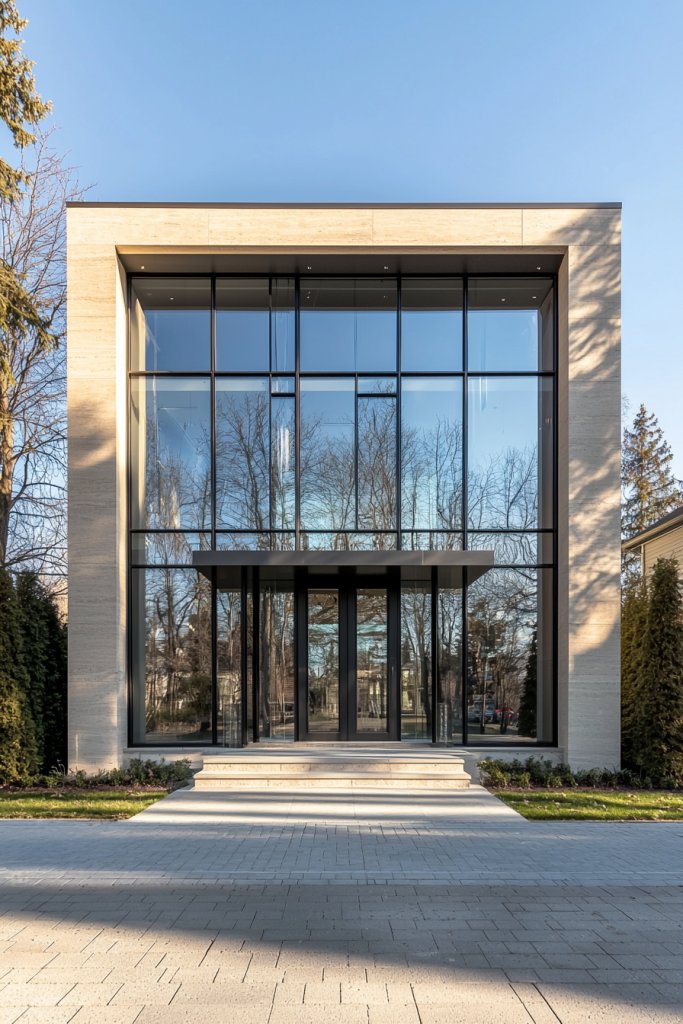
Incorporating reflective surfaces or glass elements into your front elevation instantly lends a contemporary, sleek vibe that modernizes the entire look. These elements bounce natural light, making your façade appear brighter, more expansive, and visually dynamic.
Glass and reflective finishes also introduce a sophisticated, upscale feel that’s highly appealing in current architectural trends. Visualize a front door with large glass panels framed in polished aluminum, or a façade accentuated by reflective metal cladding that mirrors the sky and surroundings.
The play of light and reflection creates a constantly changing visual experience, especially during different times of day or seasons. Clear, tinted, or frosted glass can be used depending on privacy needs and style preferences.
Incorporate reflective tiles or panels into the porch or feature wall, pairing them with neutral or bold exterior colors for a balanced look. The result is a modern, chic exterior that feels open and inviting.
To achieve this look, select high-quality glass or reflective materials suited for outdoor use—such as tempered glass, mirrored panels, or metallic cladding. For ease and safety, professional installation is recommended, especially for large or structural glass components.
For a budget-friendly alternative, reflective ceramic tiles or stainless steel sheets can be used to create a similar effect. Incorporate these elements thoughtfully around your entrance, ensuring they complement other façade features like lighting and landscaping for a cohesive, striking appearance that elevates your home’s street appeal.
Conclusion
From bold paint choices and decorative masonry to stylish doors, lighting, and landscaping, these front elevation design ideas offer endless possibilities to elevate your home’s street appeal. By incorporating architectural details, textured materials, and creative elements like sculptures or glass accents, you can create a striking and welcoming facade.
Don’t hesitate to experiment with these concepts to reflect your personal style and make a memorable first impression. Start transforming your home’s front elevation today and turn your vision into reality!
Leave a Reply